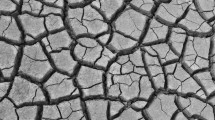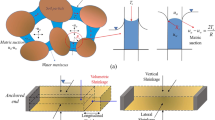Abstract
Desiccation cracking endangers the stability of expansive soils subjected to cyclic moisture variations. In the current research, prominent cracking prediction models including linear, linear elastic, linear elastoplastic, and linear elastic fracture were studied. Then, Monte Carlo limit state functions were generated based on predictions. Results indicate that there is less than 5% chance of cracking for depths beyond 0.5, 6, 8, and 9 m as predicted by the linear elastoplastic, linear elastic, linear, and linear elastic fracture models, respectively. Moreover, a series of sensitivity analysis was performed to evaluate model and parameter uncertainties. Comparatively, it was found that the linear model exhibits the highest uncertainty while linear elastoplastic model possesses the least uncertainty thus yielding a reasonable prediction. Additionally, soil parameters including matric suction followed by dry density were identified to govern the overall cracking. Using Bayesian inference, numerous conditional probabilities of variation of soil properties were investigated. Then, several cracking probabilities under history of low to high matric suction and dry density were obtained. Accordingly, Monte Carlo Markov decision chains were established based on several ecofriendly and feasible stabilization policies and their performance was also evaluated. The obtained safety factors (SF) suggest that stabilization plans resulting in high moisture and dry density have the least likelihood of cracking with a SF equal to 5.1. However, stabilization policies having low dry density and moisture yield have the least SF of 0.39. Findings of this study can improve the decision-making processes for expansive soil stabilization by considering a variety of environmental conditional probabilities.


















Similar content being viewed by others
Availability of data and materials
Data and materials can be obtained from the corresponding author upon reasonable requests.
References
Abu-Hejleh AN, Znidarčić D (1995) Desiccation theory for soft cohesive soils. J Geotech Eng 121(6):493–502
Adem HH (2015) Modulus of elasticity based method for estimating the vertical movement of natural unsaturated expansive soils. Université d’Ottawa/University of Ottawa
Amarasiri AL, Kodikara JK, Costa S (2011) Numerical modelling of desiccation cracking. Int J Numer Anal Methods Geomech 35(1):82–96
Ang AH-S, Tang WH (2007) Probability concepts in engineering planning and design: emphasis on application to civil and environmental engineering. Wiley
Bagge G (1985) Tension cracks in saturated clay cuttings. Int Conf Soil Mech Found Eng 11:393–395
Basnett C, Brungard M (1992) Clay desiccation of a landfill composite lining system. Geotech Fabr Rep 10(1)
Bernardo JM, Smith AFM (2009) Bayesian theory, vol 405. John Wiley & Sons
Boucherie RJ, Van Dijk NM (2017) Markov decision processes in practice. Springer
Bronswijk JJ, Bernardus. (1988) Modeling of water balance, cracking and subsidence of clay soils. J Hydrol 97(3–4):199–212
Cheng Q, Tang C-S, Zeng H, Zhu C, An N, Shi B (2020) Effects of microstructure on desiccation cracking of a compacted soil. Eng Geol 265:105418
Dasog CS (2002) Properties, genesis and classification of clay soils in Saskatchewan
De Cristofaro R (2008) A new formulation of the principle of indifference. Synthese 163(3):329–339
Ditlevsen O, Madsen HO (1996) Structural reliability methods, vol 178. Wiley, New York
Dyer M, Utili S, Zielinski M (2009) Field survey of desiccation fissuring of flood embankments. Proc InstCiv Eng Water Manag 162:221–232
Fenton GA, Griffiths DV (2008) Risk assessment in geotechnical engineering, vol 461. John Wiley & Sons New York
Ferson S, Tucker WT (2006) Sensitivity analysis using probability bounding. Reliab Eng Syst Saf 91(10–11):1435–1442
Fredlund DG, Rahardjo H (1993) Soil mechanics for unsaturated soils. John Wiley & Sons
Hammersley J (2013) Monte Carlo methods. Springer Science & Business Media
Hanson JA, Hardin BO, Mahboub K (1994) Fracture toughness of compacted cohesive soils using ring test. J Geotech Eng 120(5):872–891
Harison JA, Hardin BO (1994) Cracking in clays: solutions to problems in earth structures. Int J Numer Anal Methods Geomech 18(7):467–484
Jalal FE, Xu Y, Jamhiri B, Memon SA (2020) On the recent trends in expansive soil stabilization using calcium-based stabilizer materials (CSMs): a comprehensive review. Adv Mater Sci Eng 2020
James J (2020) Sugarcane press mud modification of expansive soil stabilized at optimum lime content: strength, mineralogy and microstructural investigation. J Rock Mech Geotech Eng 12(2):395–402
Jamhiri B, Yongfu X, Jalal FE, Chen Y (2021) Hybridizing neural network with trend-adjusted exponential smoothing for time-dependent resistance forecast of stabilized fine sands under rapid shearing. Transp Infrastruct Geotechnol:1–20
Kodikara, J, L Barbour, D G Fredlund, and X Choi. 2011. “Theoretical analysis of desiccation cracking of a long soil layer.” On Review.
Kodikara JK, Choi X (2006) A simplified analytical model for desiccation cracking of clay layers in laboratory tests. Unsaturated Soils 2006:2558–2569
Kodikara J, Costa S (2013) Desiccation cracking in clayey soils: mechanisms and modelling. In: Multiphysical Testing of Soils and Shales. Springer, pp 21–32
Konrad J-M, Ayad R (1997a) Desiccation of a sensitive clay: field experimental observations. Can Geotech J 34(6):929–942
Konrad J-M, Ayad R (1997b) A idealized framework for the analysis of cohesive soils undergoing desiccation. Can Geotech J 34(4):477–488
Lachenbruch AH (1961) Depth and spacing of tension cracks. J Geophys Res 66(12):4273–4292
Lau JTK (1987) Desiccation cracking of soils. University of Saskatchewan
Li JH, Zhang LM (2011) Study of desiccation crack initiation and development at ground surface. Eng Geol 123(4):347–358
Liangtong Z (2003) Field and laboratory study of an unsaturated expansive soil associated with rain-induced slope instability. The Hong Kong University of Science and Technology, Hong Kong
Lopez-Bellido RJ, Muñoz-Romero V, Lopez-Bellido FJ, Guzman C, Lopez-Bellido L (2016) Crack formation in a Mediterranean rainfed vertisol: effects of tillage and crop rotation. Geoderma 281:127–132
Luo R, Prozzi JA (2009) Combining geogrid reinforcement and lime treatment to control dry land longitudinal cracking. Transp Res Rec 2104(1):88–96
Mabirizi D, Bulut R (2010) Unified testing method for measuring diffusion coefficients for unsaturated soil drying and wetting in laboratory. Transp Res Rec 2170(1):109–118
Maedo M, Sánchez M, Aljeznawi D, Manzoli O, Guimarães LJN, Cleto PR (2020) Analysis of soil drying incorporating a constitutive model for curling. Acta Geotech 15(9):2619–2635
Miao L, Houston SL, Cui Y, Yuan J (2007) Relationship between soil structure and mechanical behavior for an expansive unsaturated clay. Can Geotech J 44(2):126–137
Miao L, Liu S, Lai Y (2002) Research of soil–water characteristics and shear strength features of Nanyang expansive soil. Eng Geol 65(4):261–267
Miller GA, Hassanikhah A, Varsei M (2015) Desiccation crack depth and tensile strength in compacted soil. In: Unsaturated Soil Mechanics-from Theory to Practice: Proceedings of the 6th Asia Pacific Conference on Unsaturated Soils (Guilin, China, 23-26 October 2015), 79. CRC Press
Mongillo G, Shteingart H, Loewenstein Y (2014) The misbehavior of reinforcement learning. Proc IEEE 102(4):528–541
Morris PH, Graham J, Williams DJ (1992) Cracking in drying soils. Can Geotech J 29(2):263–277
Morris PH, Graham J, Williams DJ (1994) Crack depths in drying clays using fracture mechanics. Geotech Spec Publ 43:40–53
Müller P, Sansó B, De Iorio M (2004) Optimal Bayesian design by inhomogeneous Markov chain simulation. J Am Stat Assoc 99(467):788–798
Nahlawi H, Kodikara JK (2006) Laboratory experiments on desiccation cracking of thin soil layers. Geotech Geol Eng 24(6):1641–1664
Nelson J, Miller DJ (1997) Expansive soils: problems and practice in foundation and pavement engineering. John Wiley & Sons
Nikolaidis E, Ghiocel DM, Singhal S (2004) Engineering design reliability handbook. CRC press
Péron H, Delenne J-Y, Laloui L, El Youssoufi MS (2009) Discrete element modelling of drying shrinkage and cracking of soils. Comput Geotech 36(1–2):61–69
Picornell M, Lytton RL (1989) Field measurement of shrinkage crack depth in expansive soils. Transp Res Rec 1219:121–130
Puppala AJ, Manosuthikij T, Chittoori BCS (2013) Swell and shrinkage characterizations of unsaturated expansive clays from Texas. Eng Geol 164:187–194
Puterman ML (2014) Markovdecision processes: discrete stochastic dynamic programming. John Wiley & Sons
Rayhani MHT, Yanful EK, Fakher A (2008) Physical modeling of desiccation cracking in plastic soils. Eng Geol 97(1–2):25–31
Rebba R, Mahadevan S (2008) Computational methods for model reliability assessment. Reliab Eng Syst Saf 93(8):1197–1207
Shadab Far M, Wang Y (2016) Approximation of the Monte Carlo sampling method for reliability analysis of structures. Math Probl Eng 2016
Shrestha A, Jotisankasa A, Chaiprakaikeow S, Pramusandi S, Soralump S, Nishimura S (2019) Determining shrinkage cracks based on the small-strain shear modulus–suction relationship. Geosciences 9(9):362
Sigaud O, Buffet O (2013) Markov decision processes in artificial intelligence. John Wiley & Sons
Song W-K, Cui Y-J (2020) Modelling of water evaporation from cracked clayey soil. Eng Geol 266:105465
Tang C, Shi B, Liu C, Zhao L, Wang B (2008) Influencing factors of geometrical structure of surface shrinkage cracks in clayey soils. Eng Geol 101(3–4):204–217
Terzaghi K, Peck RB, Mesri G (1996) Soil mechanics in engineering practice. John Wiley & Sons
Vanapalli S, Oh W (2010) A model for predicting the modulus of elasticity of unsaturated soils using the soil-water characteristic curve. Int J Geotech Eng 4(4):425–433
Vehtari A, Ojanen J (2012) A survey of Bayesian predictive methods for model assessment, selection and comparison. Stat Surv 6:142–228
Villar MV, Lloret A (2008) Influence of dry density and water content on the swelling of a compacted bentonite. Appl Clay Sci 39(1–2):38–49
Vo TD, Pouya A, Hemmati S, Tang AM (2019) Modelling desiccation crack geometry evolution in clayey soils by analytical and numerical approaches. Can Geotech J 56(5):720–729
Vu HQ, Hu Y, Fredlund DG (2007) Analysis of soil suction changes in expansive Regina clay. In: 60th Canadian Geotechnical Conference, OttawaGeo, 1–8
Wan Y, Xue Q, Liu L, Wang SY (2018) Relationship between the shrinkage crack characteristics and the water content. Soils Found 58(6):1435–1445
Wang J-J, Zhang H-P, Zhang L, Liang Y (2013) Experimental study on self-healing of crack in Clay seepage barrier. Eng Geol 159:31–35
Wijesooriya RMSD (2012) Modelling of desiccation crack depths in clay soils. Monash University
Wu L, Ji W, AbouRizk SM (2020) Bayesian inference with Markov chain Monte Carlo–based numerical approach for input model updating. J Comput Civ Eng 34(1):4019043
Xu Y, Huang J, Yanjun D, De’an Sun. (2008) Earth reinforcement using soilbags. Geotext Geomembr 26(3):279–289
Xu Y, Zhang H-r (2021) Design of soilbag-protected slopes in expansive soils. Geotext Geomembr
Yesiller N, Miller CJ, Inci G, Yaldo K (2000) Desiccation and cracking behavior of three compacted landfill liner soils. Eng Geol 57(1–2):105–121
Acknowledgements
The key project of the National Natural Science Foundation of China (Grant No. 41630633), National Key Research and Development Project (Grant No. 2019YFC1509800), and Key Special Project of the Ministry of Science and Technology of the People’s Republic of China for Monitoring, Warning, and Prevention of Major Natural Disasters are acknowledged for the financial support.
Author information
Authors and Affiliations
Contributions
BJ: conceptualization, methodology, formal analysis, original draft; YX: supervision, reviewing and editing; and FEJ: reviewing and editing.
Corresponding author
Ethics declarations
Ethics approval and consent to participate
Not applicable.
Consent for publication
The manuscript is original and unpublished and is not being considered for publication elsewhere. The authors allow this research paper to be published upon acceptance in the Journal of Environmental Science and Pollution Research.
Competing interests
The authors declare no competing interests.
Additional information
Responsible Editor: Marcus Schulz
Publisher’s note
Springer Nature remains neutral with regard to jurisdictional claims in published maps and institutional affiliations.
Rights and permissions
About this article
Cite this article
Jamhiri, B., Xu, Y. & Jalal, F.E. Cracking propagation in expansive soils under desiccation and stabilization planning using Bayesian inference and Markov decision chains. Environ Sci Pollut Res 29, 36740–36762 (2022). https://doi.org/10.1007/s11356-022-18690-5
Received:
Accepted:
Published:
Issue Date:
DOI: https://doi.org/10.1007/s11356-022-18690-5




